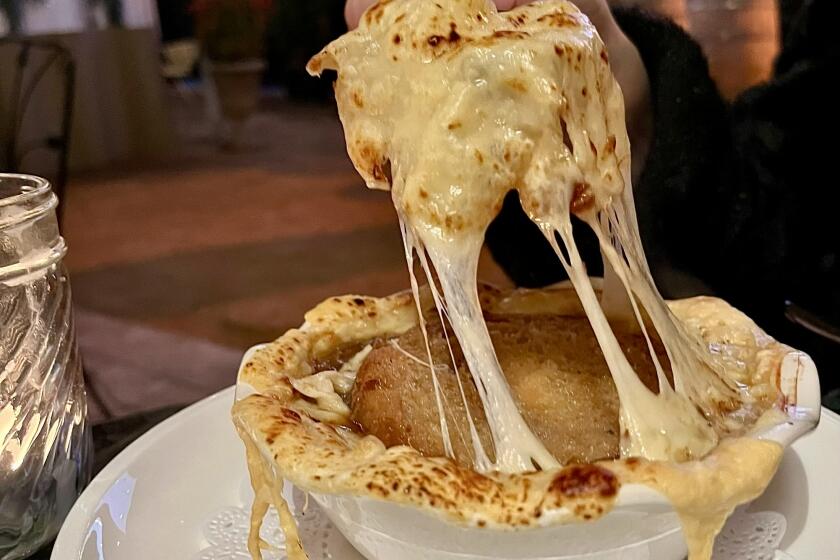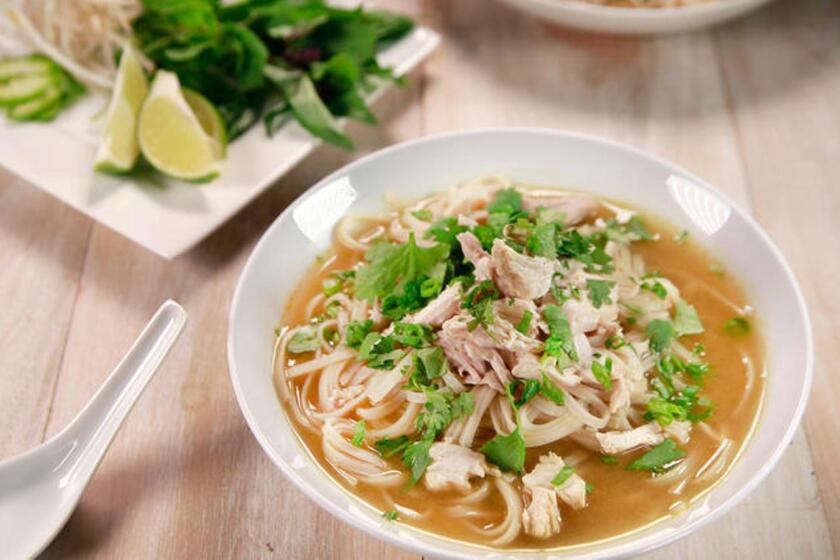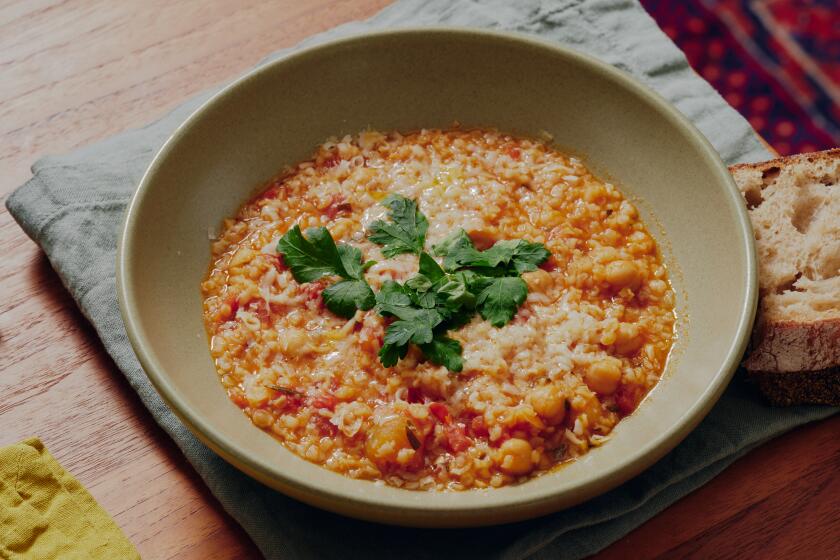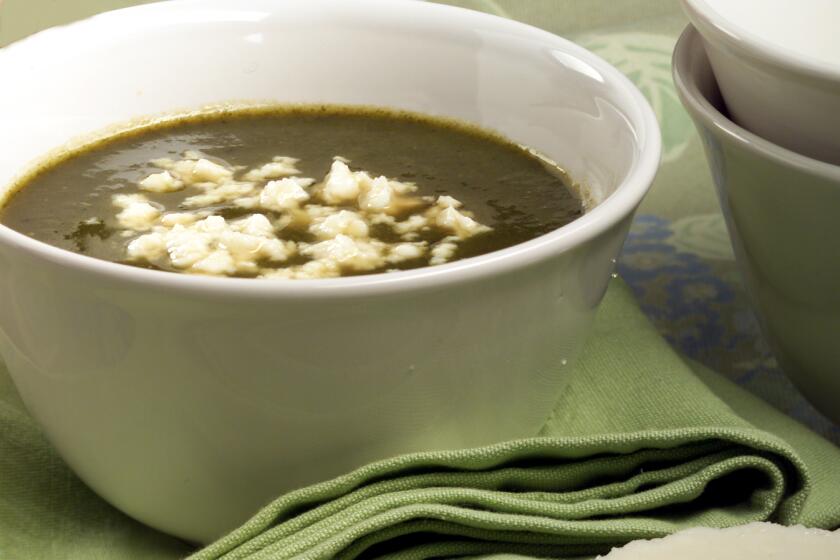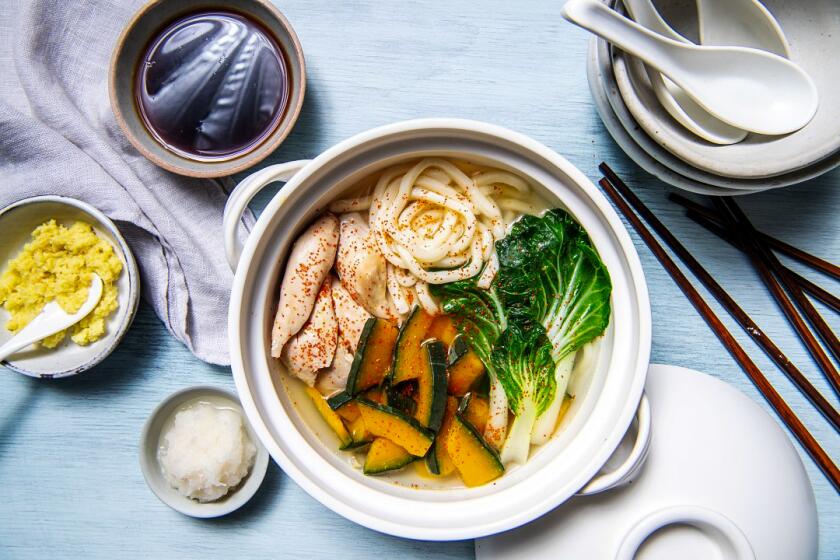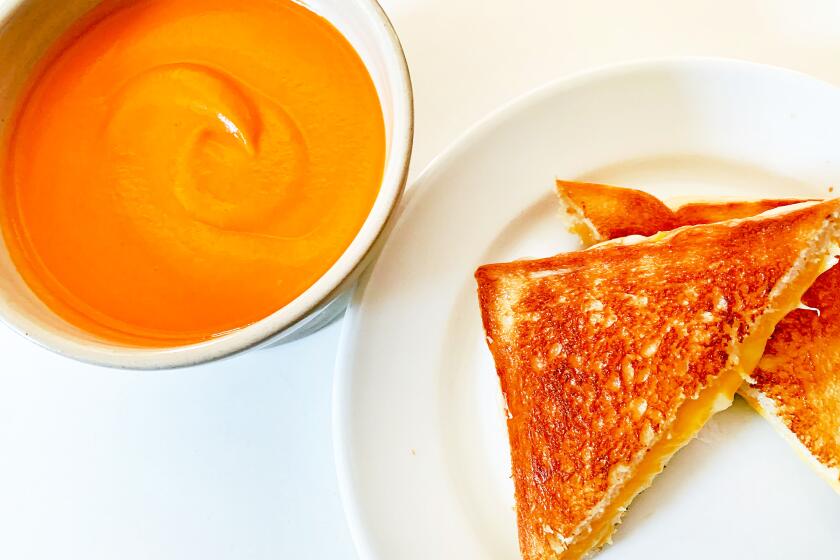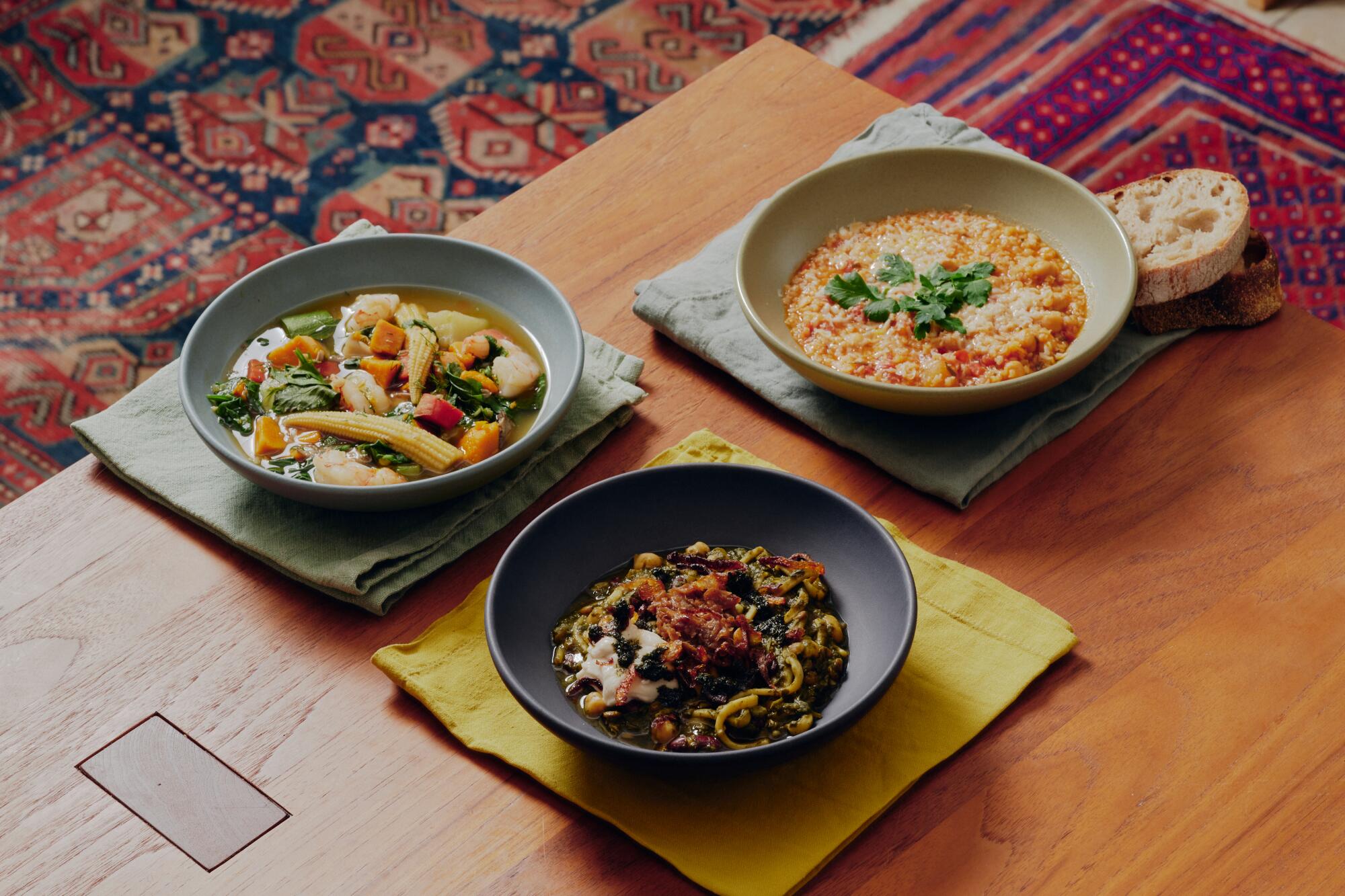
- Share via
Late last year, my husband and I returned from a vacation in France some pounds heavier than we wanted to be.
“That’s it,” I said. “From now on, it’s soup for dinner.”
Soup is delicious, filling and moderately low in calories — if one goes easy on the cream and fatty meats. It’s the easiest way I’ve found to cut back.
Amp the umami and other taste notes with these unexpected flavor spikes and your soup will never be boring.
When eating soup, my husband and I frequently remarked on the lovely sensation of being nourished, as if we could feel nutrients entering our bloodstreams.
And another great thing about soup for dinner? Make a nice big pot and you’ve got a night or two off from cooking.
For the diet’s duration — with timeouts during the holidays for gravy, latkes, cookies and pie — I still threw dinner parties ... and fed people soup.
A friend asked, dubiously, “Do you, uh, allow carbohydrates in your soups?”
Absolutely! Maybe I didn’t always add as many noodles, rice or potatoes as a recipe called for, but nobody ever complained. Or noticed.
There was one thing I wanted to ensure before we began: I would not be bored or boring as a cook or an eater on this diet. My husband might have been happy with mushroom barley soup most nights, but I was determined to cook around the world. In soup.
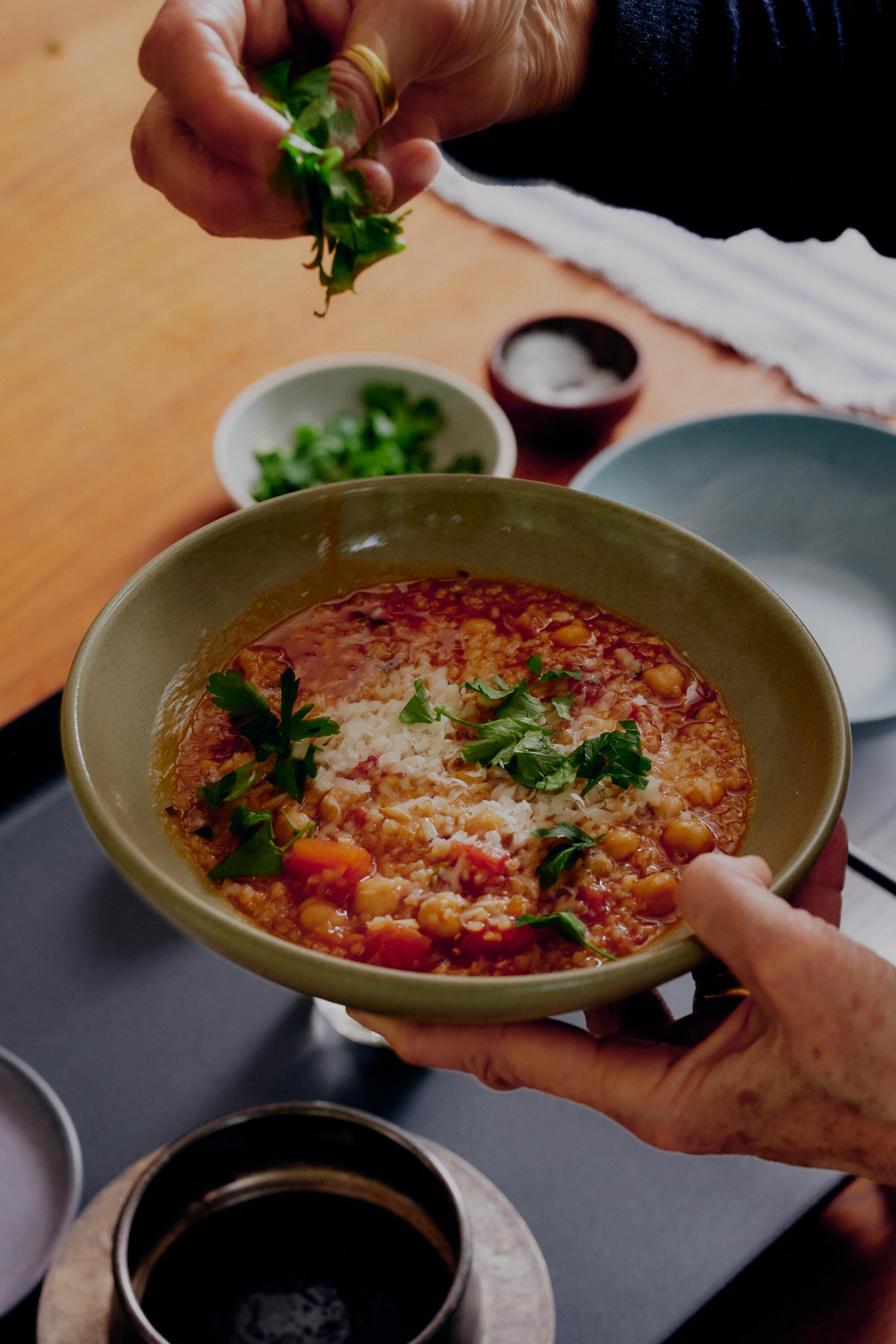
Green chicken posole ... couscous as a soup ... borscht ... Roman-style chickpea and tomato soup with bulgur ...
The first soup I made was a souvenir from our honeymoon in Rome. There, footsore and exhausted one afternoon, we ordered pasta and insalata for lunch in a busy café on Via del Gesù and were promptly served bowls of ceci (chickpea) soup.
“Comes with,” the server explained.
Redolent of garlic and rosemary, brothy, flecked with tomatoes and a few tiny pasta pieces, the soup perked us up. Once home in Altadena, I re-created that soup to my best ability. Quick, easy, deeply flavorful, it’s been a favorite ever since. Recently, in place of the pasta, I added bulgur, giving the soup a new heft and addictive chewy texture.
1
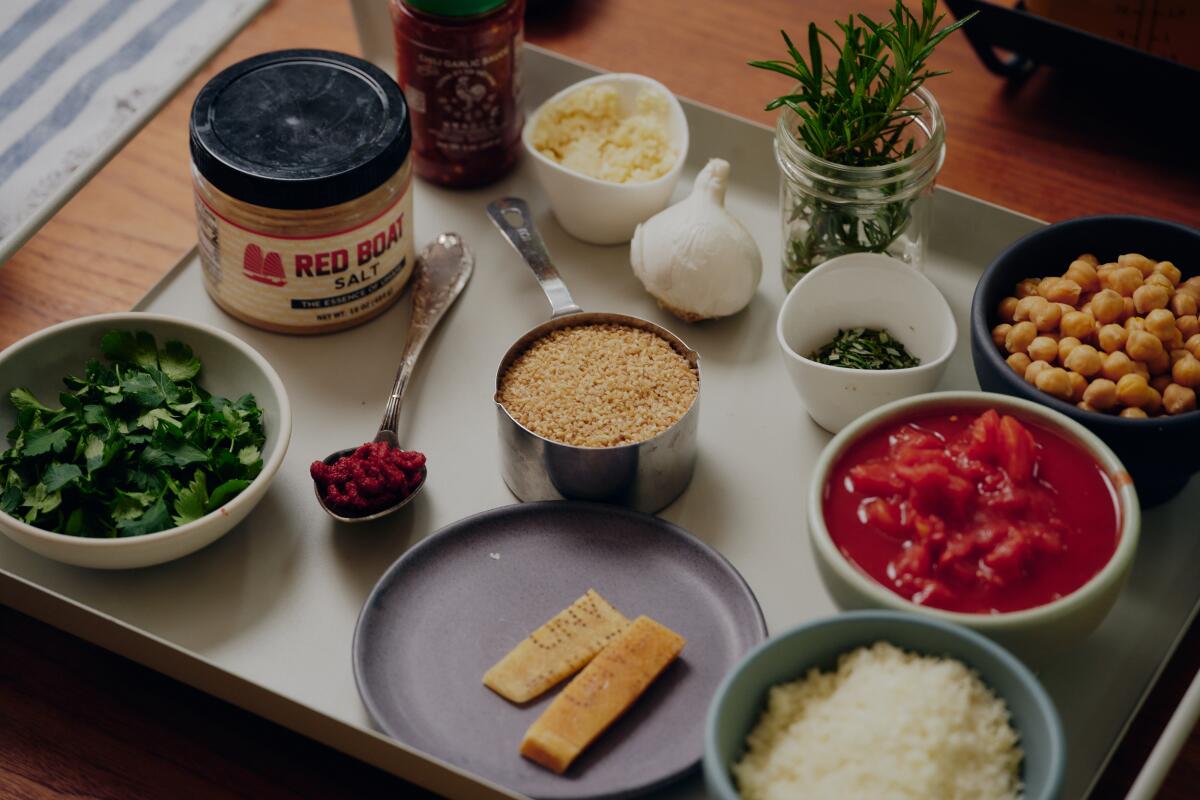
2
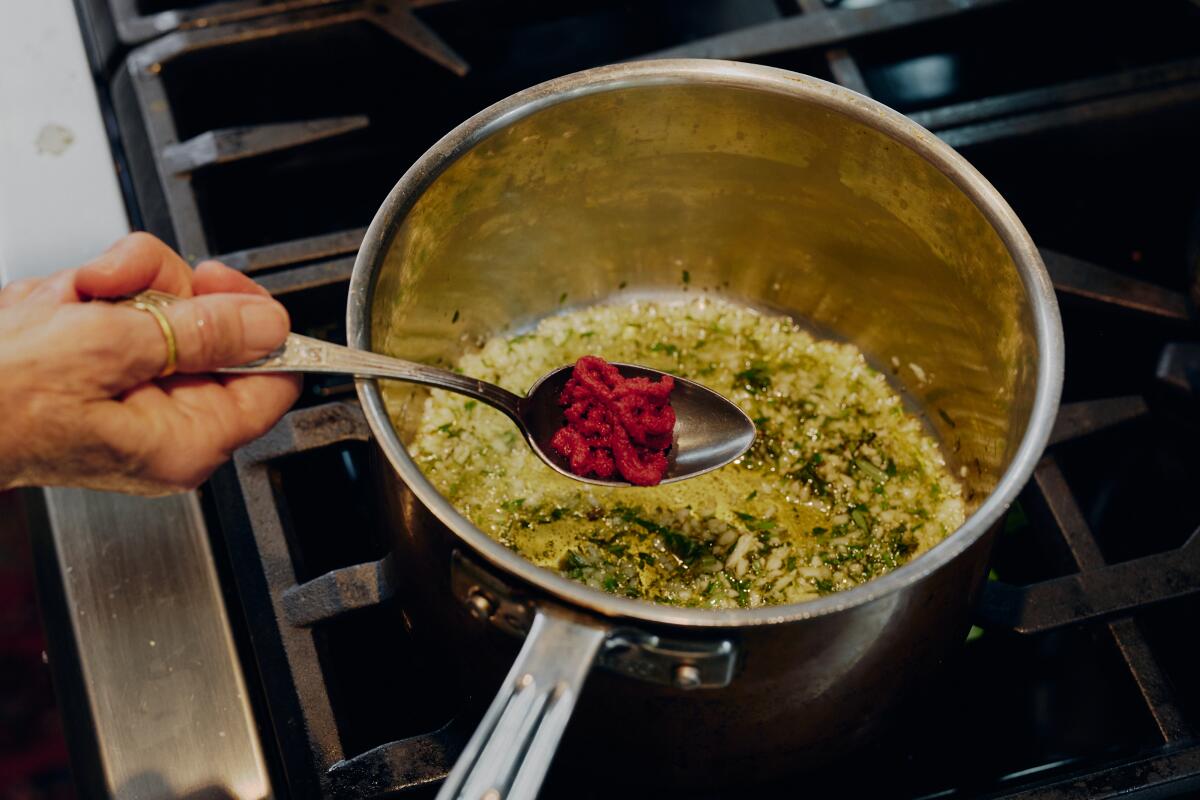
1. The makings of Michelle Huneven’s Roman-style Chickpea and Tomato Soup with Bulgur, including optional Parmesan rinds for enhanced umami. 2. Tomato paste is added to the pot to Roman-style Chickpea Soup and Tomato with Bulgur. (Photos by Shelby Moore / For The Times)
Kabocha with quince soup ... smoky eggplant soup ... white bean and cabbage soup ... green soup ...
One cookbook I turned to often was “Love Soup” by Anna Thomas, who always includes useful cooking tips in her recipes. For example, in her recipe for an irresistible green soup, she explains how to caramelize onions — the main ingredient is patience, along with faith and a good 45 minutes. She also advises not to overprocess pureed soup if it includes potato: “It can get slimy if you work it too much.”
Good to know!
Two of my favorite Los Angeles restaurants for great French onion soup
Giant lima and sauteed escarole soup ... chicken pho ... soupe au pistou ...
To make soup, one needs broth. And yes, yes: It is always better to make your own broth. Throughout these months, I have made gallons and gallons of vegetable stock, basic chicken stock and dashi.
But sometimes, I confess, I’ll crack a store-bought box of broth. And occasionally, when I need just a cupful more, I’ll resort to a teaspoon of low-sodium Better Than Bouillon in a cup of boiling water. There are times when usefulness trumps artfulness.
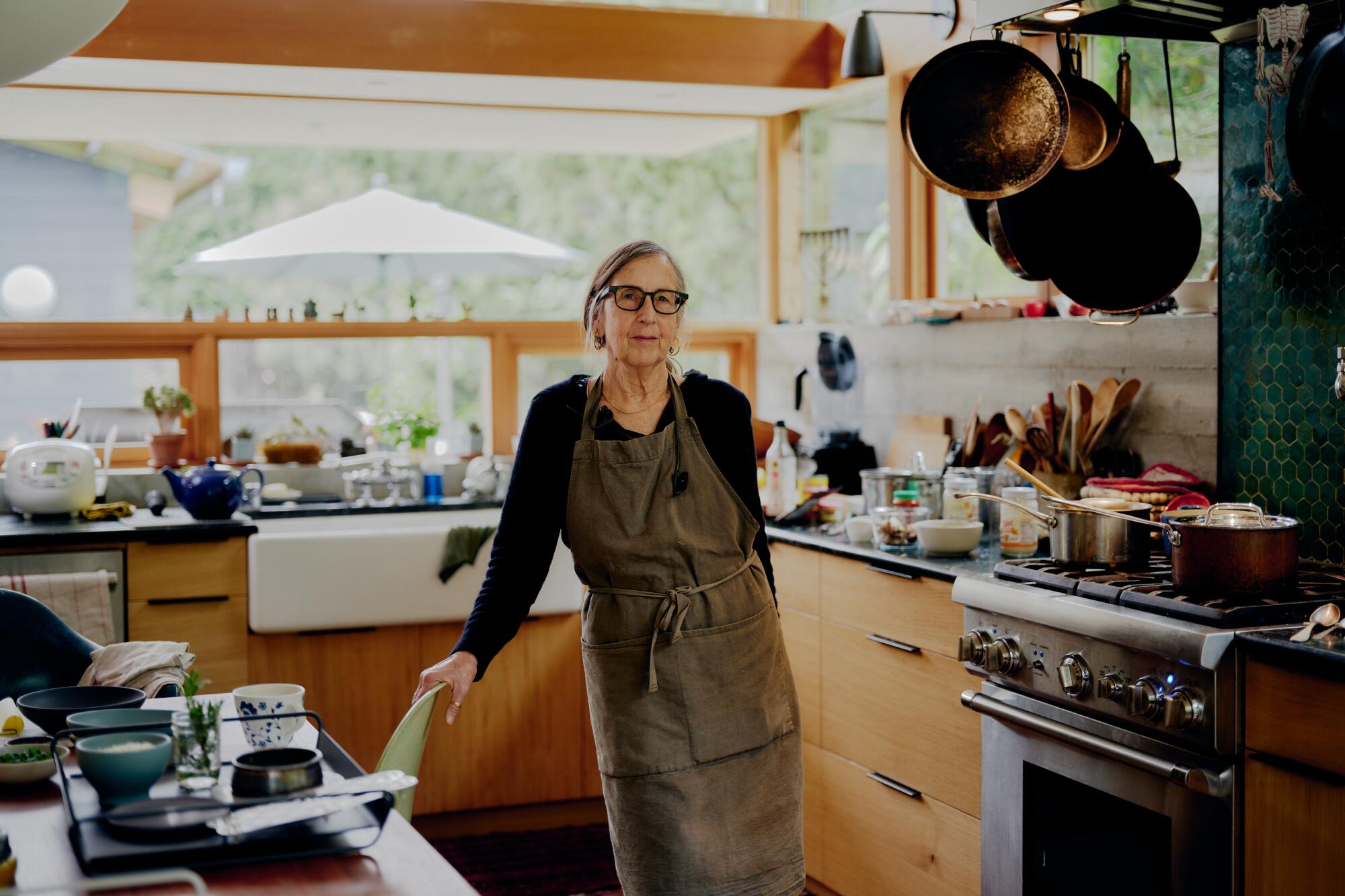
Miso soup with tofu ... red lentil soup ... Italian wedding soup ... donabe pot soup …
The easiest soup I made was in a donabe, the traditional clay pot from Japan that goes on the burner. Using a dashi soup base (homemade or from a store-bought concentrate), I simmered vegetables — cabbage, bok choy, scallions, winter squash, mushrooms, carrots, etc. Add a poached egg, tofu, cooked soba or udon noodles and dinner becomes substantial.
Many soups start in a similar way, with a mirepoix, a sauté of flavoring vegetables. One chops the onion, and/or the celery, carrots and garlic, then sautés them. This forms the basic flavor base.
The trick here is to sauté the mirepoix until the flavors bloom — and are at their most contagious. Next add your liquid. Identifying that optimal moment takes practice and a good nose. It is, I believe, one mark of a good cook.
I learned (the hard way) to preheat serving bowls so the soup doesn’t cool down en route to the table. A brief stint in a 250-degree oven or even a dousing with hot tap water keeps the bowl from stealing heat, which can result in merely warm soup.
Aromatic broths and hearty vegetable soups are the best way to revive more than just your health.
Artichoke stew ... potato soup with Indian spices ... triple mushroom soup … kaeng lieng ...

I’ll sometimes splurge on seafood and put it in a Thai-style soup or simple tomato-based chowder.
I had a memorable Thai red curry soup when a friend served it to me in England and I had a cut on my tongue. His soup was wildly spicy-hot — so incredibly painful to eat — but also so delicious, I couldn’t stop eating it. (As food historian and former L.A. Times Food staff writer Charles Perry once said, “The flavor of spice heat is pain.”) It’s a terrific vehicle for shrimp, clams, mussels, scallops, firm white fish …
If guests can’t tolerate even the moderate heat of a red curry soup, I’ll make a milder tom kha talay — a Thai seafood soup flavored with lemongrass, makrut lime and coconut milk that I learned from my neighbor Michele, who lived in Thailand for nine years.
Michele recently told me about a different Thai soup, kaeng lieng, a shrimp soup so nourishing that it is recommended to nursing mothers. She had used a flavor packet she’d bought at the Silom market in Thai Town. I read the ingredients on the packet and decided I’d try to make kaeng lieng from scratch.
I consulted recipes on the internet and ordered two of the dominant flavoring agents: shrimp powder and shrimp paste, the latter an umami source so intense, it strays into funk.
A third classic ingredient is fingerroot, also known as grachai and Chinese ginger, which I was unable to find in nearby Asian stores. But if we cooks learned anything from the pandemic, it’s that missing one ingredient shouldn’t stop us from making a recipe.
I made the soup. With orange carrots and kabocha squash, green zucchini and chayote, yellow baby corn, fat white shrimp and handfuls of spinach and lemon basil, it’s an eye-catching, colorful, leafy soup.
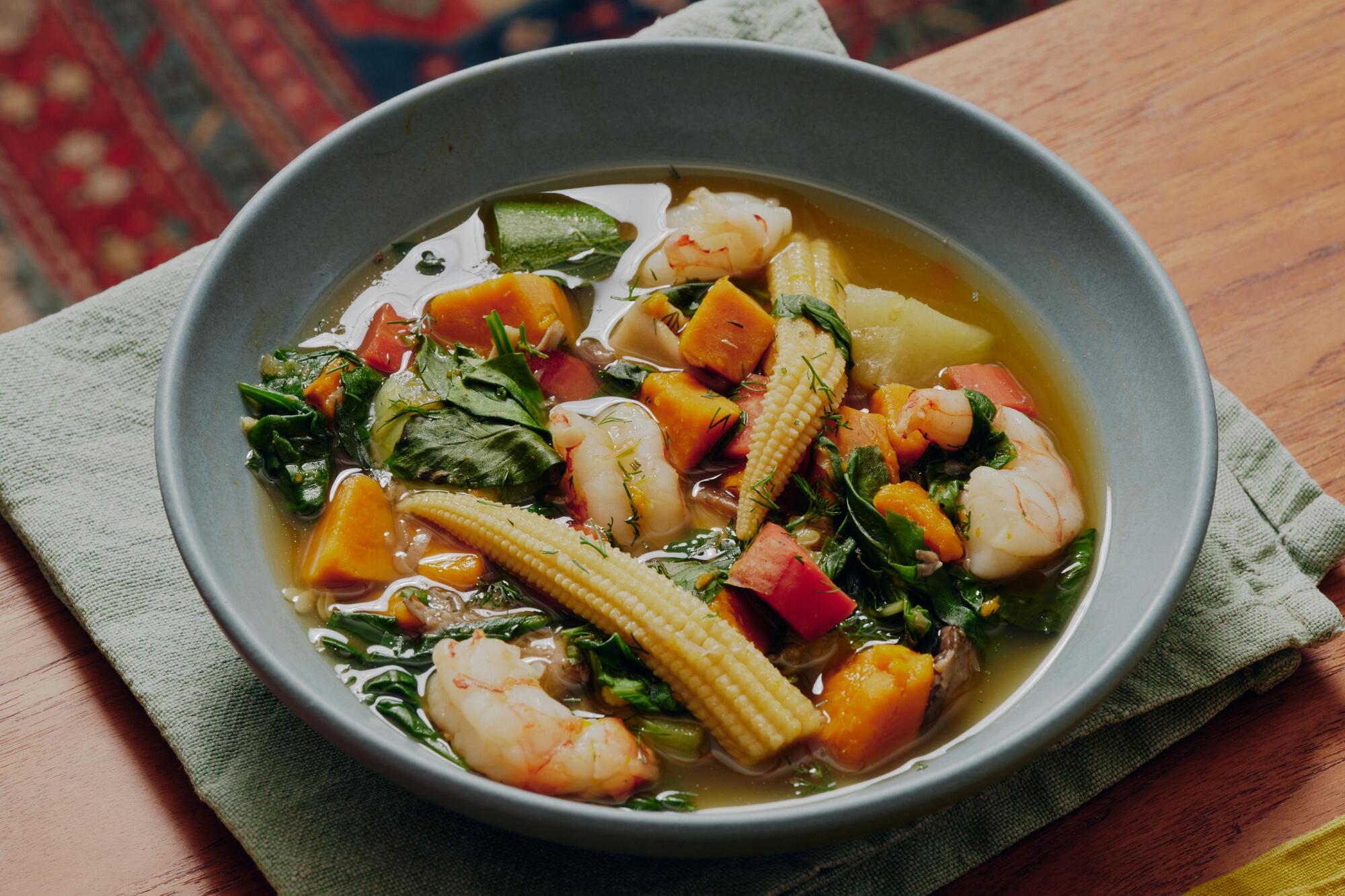
The first mouthful was … intense.
“Maybe a little funky for me,” I said.
“Yeah. Not so sure about this one,” my husband said.
We kept eating. Then something kicked in. And we started gobbling. The crunch of baby corn! The way kabocha melted against the tongue! That startling new flavor — we couldn’t get enough of it. We finished one bowl and went for a second.
“Hold on,” I said, as we rose to get thirds. “We have to save a little to see if it tastes at all authentic to Michele.” (I still worried about the lack of fingerroot.)
Michele came over for a taste.
“Oh yes. That’s it,” she said, and promptly polished off the pot.
Making these tomato soup and grilled cheese recipes is easy. They require few pantry ingredients and just a little patience.
Tortilla soup ... corn chowder ... seafood chowder ... ash reshteh ...
As I browsed through cookbooks and websites, one Persian soup kept catching my eye. I love the lamb stew gormeh sabzi, which has chopped greens and kidney beans, and this recipe did too but was vegetarian — a plus!
Ash reshteh is named for reshteh, its square-edged, slightly salted, linguini-like noodle. Otherwise, it seems as if ash reshteh is one of those soups that probably has as many variations as home cooks who make it — some recipes call for only chickpeas, others for chickpeas and one to three other kinds of beans. Some recipes say to stir in a whole bottle of kashk (a fermented whey sauce) before serving, while others use kashk as a garnish and still others omit it in favor of yogurt, kefir or a vegan cashew cheese sauce. Variations include or exclude garlic, dill and mint. One recipe asks for a bunch of spinach, another a pound, a third for two pounds.
This was my kind of soup — the you-can’t-make-a-mistake kind of soup. The make-it-even-if-you-can’t-find-one-ingredient kind of soup. A generous soup.
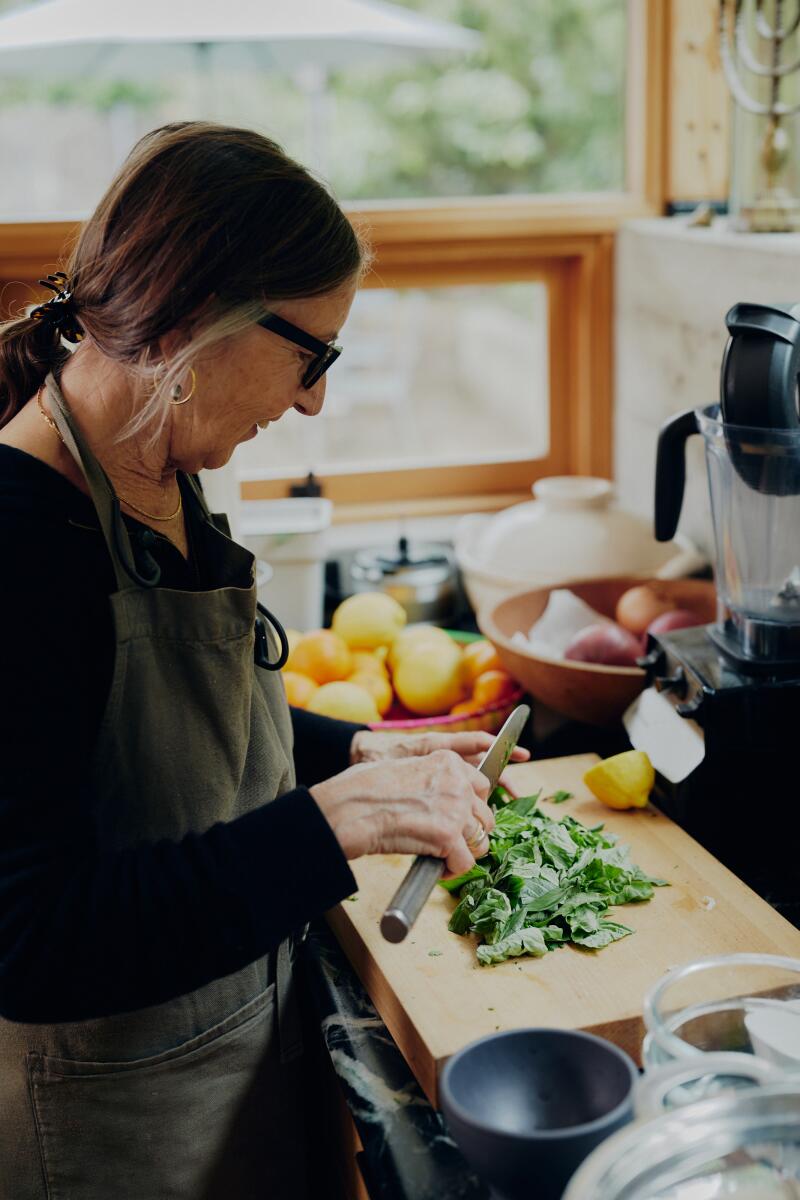
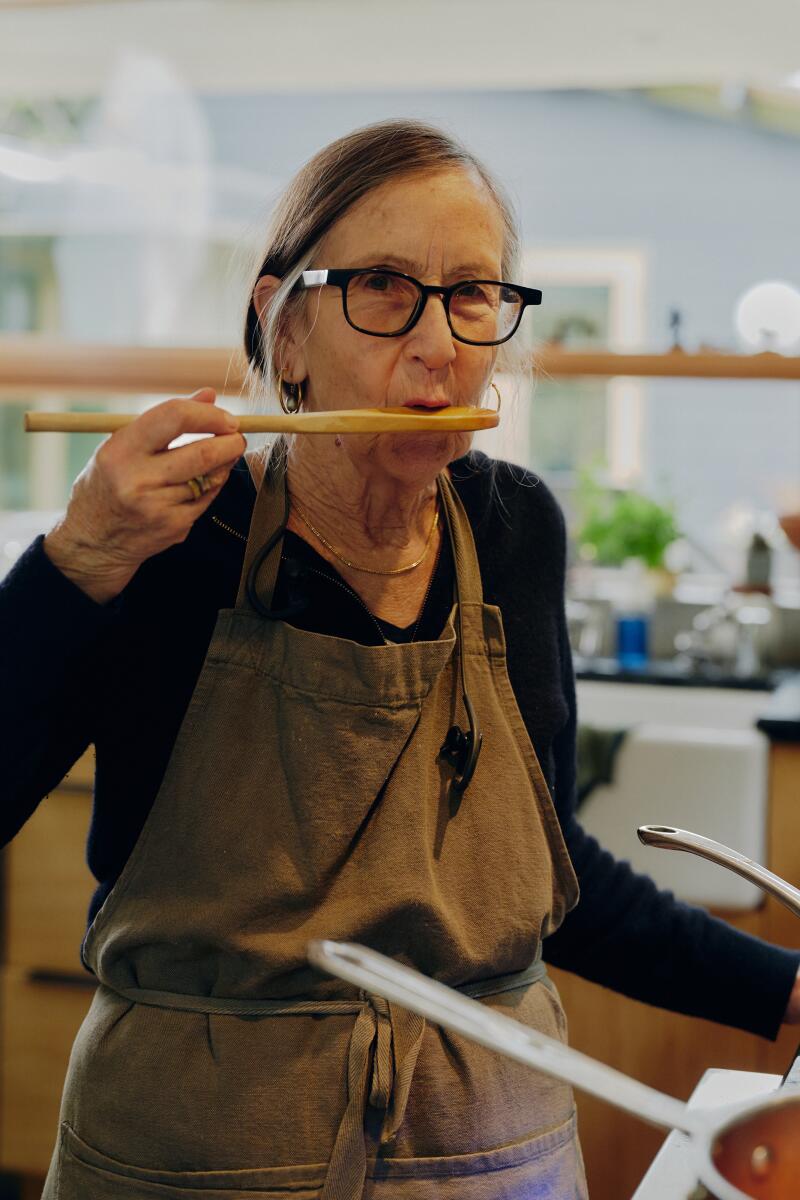
Michelle Huneven chops fresh herbs for soup and later tastes the results in her Altadena kitchen. (Shelby Moore / For The Times)
I used — more or less — the recipe on the package of reshteh noodles I bought, although I ignored the instruction to soak dried chickpeas and beans overnight to cook in the morning. Reader, I used canned.
I served it to 10 people. They loved it.
And still, the first time making ash reshteh, I was reminded that in some cultures, women spend whole days in the kitchen.
I had feared the chopping of the greens, but the time-consuming part was really, as ever, the caramelizing of onions.
The garnished bowlfuls — the green soup with red kidney beans, ribbony yellow noodles, snow-white kashk, golden-brown onions and a drizzle of dark green mint oil — look like beautiful little oil paintings.
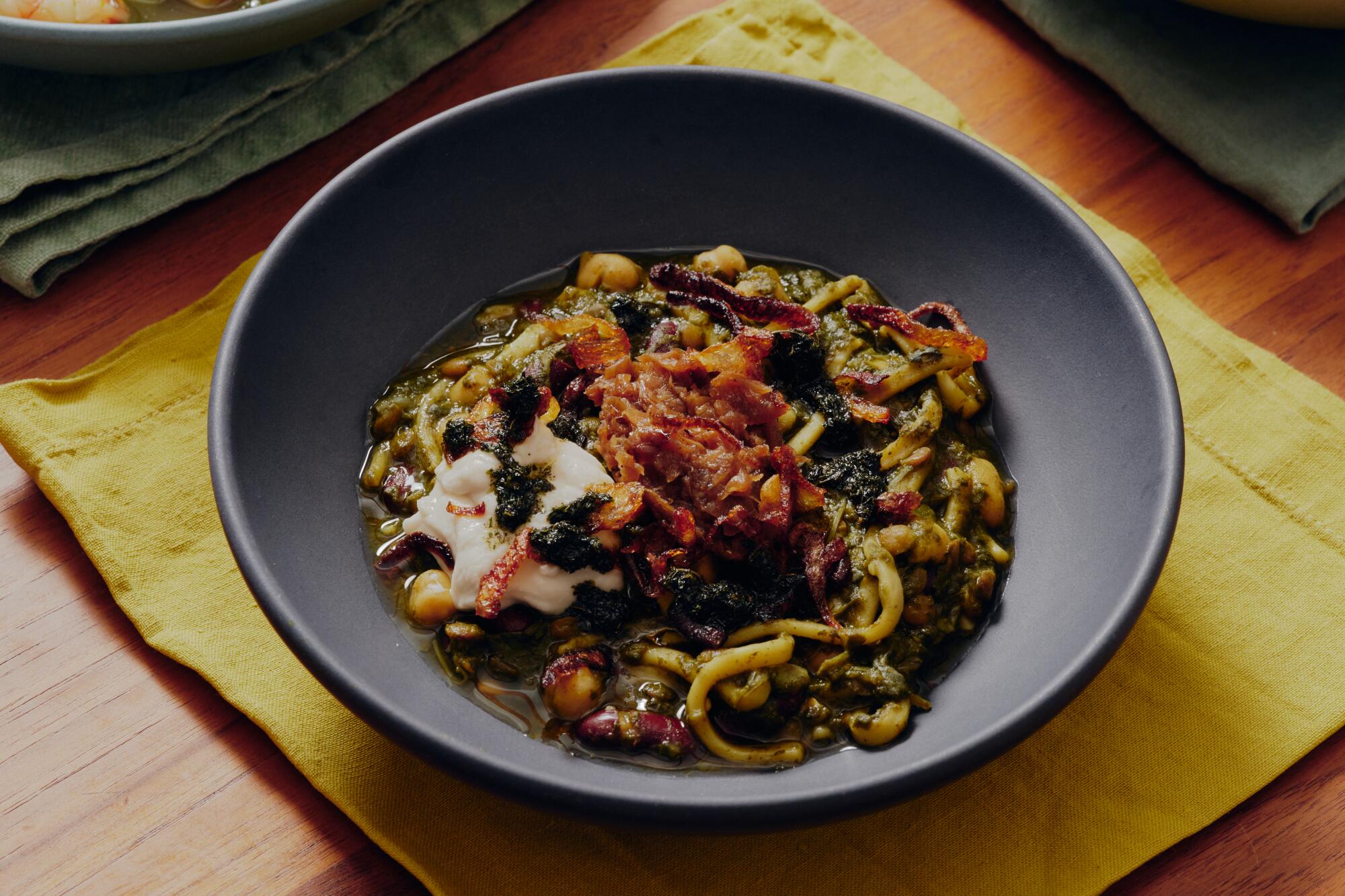
When I finished making my last pot of ash reshteh, it was at the end of a long day. Exhausted, I served myself a bowlful — and was instantly, almost uncannily revived.
Lentil soup ... kabocha, bean and potato stew ... cauliflower soup ... tortellini en brodo ... tomato soup ...
Sometime in January, we shed our extra pounds, at which point we added salad and bread to our soup dinners. We are, however, still eating a lot of soup. Even after four months and 40-odd soups, I feel as if I’ve barely scratched the surface of soup.
And my husband is game. He said, “I went to college in New England where the science building was high up on a hill and the commons, where the freshmen had to eat, was down at the foot of the hill. In the winter, I’d go down to meals with two friends of mine, two women, who would set off by saying, ‘Eight minutes to soup.’ ... And then, as we descended, ‘Five minutes to soup … two minutes to soup.’ I never really appreciated their enthusiasm — till now.”
Huneven’s most recent novel, “Search,” was published in 2022 by Penguin Press.
The recipes
Roman-style Chickpea and Tomato Soup With Bulgur
Kaeng Lieng (Thai Vegetable Soup With Shrimp)
Ash Reshteh (Persian Beans, Greens and Noodle Soup)
Anna Thomas' Great Green Soup
Kabocha Squash and Chicken Hot Pot
Soupe au pistou (vegetable soup with garlic and basil)
Creamy Tomato Soup
Pozole verde (green pozole)
More to Read
Eat your way across L.A.
Get our weekly Tasting Notes newsletter for reviews, news and more.
You may occasionally receive promotional content from the Los Angeles Times.

